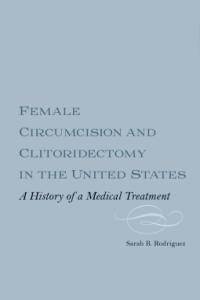Not the book on female maladies I’d hoped for
Female Circumcision and Clitoridectomy in the United States: A History of a Medical Treatment
Sarah B. Rodriguez
Having previously done research into hysteria and its connection to the female body, I was quite eager to read Sarah B. Rodriguez’s study on female genital correction and mutilation. These ‘treatments’ have a long history in curing women from all kinds of supposed ailments, but most histories focus on Victorian England. Since my own research had focused on the racial aspects of diagnosing hysteria, an American history would seem useful research material indeed.
Most of this book, however, does not deal with hysteria or other kinds of disease, but with sexual dysfunctions for which the so-called liberation of the clitoris was considered a helpful treatment. This is quite interesting, too, but unfortunately a reader is never quite clear what exactly the overarching theme of the book is. There are four chapters that cover the period 1890-1940, one that covers 1940-1966, and two on 1966-89, but in the introduction, Rodriguez begins by mentioning an article on genital plastic surgery from 2012. The connection with the twenty-first century, which is hinted at here, is not picked up again until the conclusion, though such an inclusion would certainly have been helpful in determining which practices mentioned in the book are still common today.
The book is for the most part reporting from historical sources, with occasional interpretations or opinions by the author. The introduction and conclusion are very different in tone, however, as both chapters convey the author’s position very strongly. Her presentation of the sources is extremely inclusive, as a third of the book is devoted to the footnotes and bibliography, yet in the text itself the incessant quotation from as many sources as possible becomes fatiguing. At times, several pages are dedicated to a summing up of quotations that all convey the same idea, and only differ in the source.
One point of criticism must go to the editor, too. My job was not at all made easier by the fact that I was given a very sloppily constructed e-book. The chapter divisions had not been coded in, but what was worse, all page headings had been transcribed into the text at the exact position of the page break in the original paper book. This led to hopeless sentences such as this: “Her unresponsiveness, however, troubled her, or her husband, enough to seek a female circumcision to promote clitoral orgasm – 89 medical remedy.” ‘Female circumcision to promote clitoral orgasm’ is the chapter title, which has been seamlessly absorbed into the main text.
By far the most interesting chapter of this book is the conclusion. This, in my opinion, is not a good thing. A conclusion should connect the overarching themes of the rest of the work, as every freshman is told in essay-writing class, but Rodriguez introduces the comparison between African female genital mutilation and US female genital correction for the first time here. Elaboration on this topic much earlier on in the book would have made the topic much clearer, more accessible and more interesting for a wide audience. However, according to the publisher, the hardcover version is on sale for $70, which is a price that would deter any kind of wide audience – I must advise you against spending that much money on this book.
